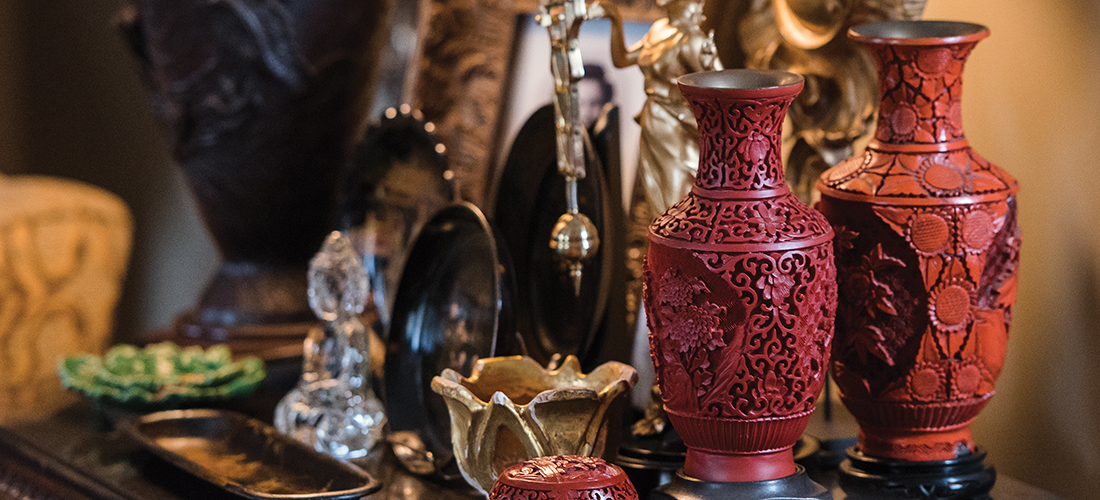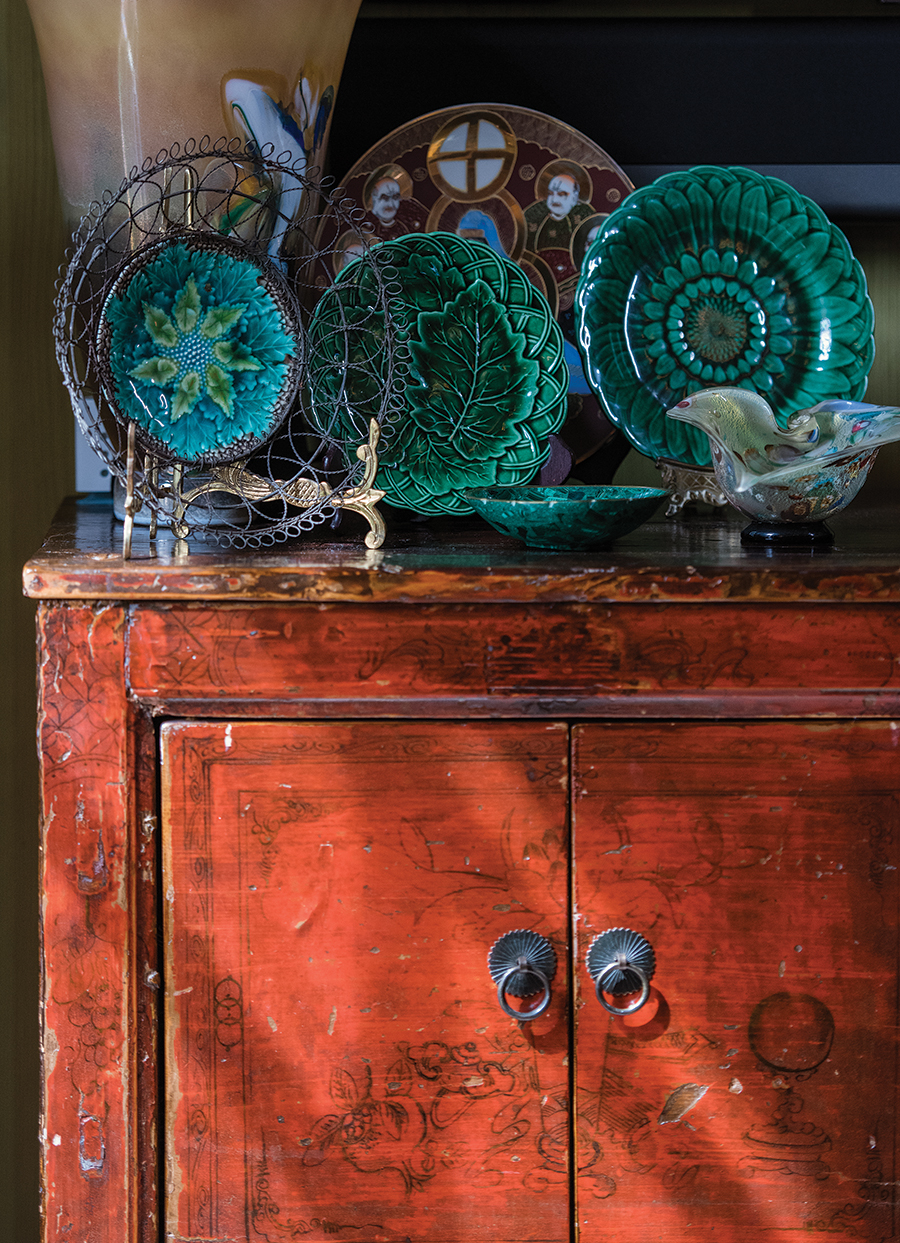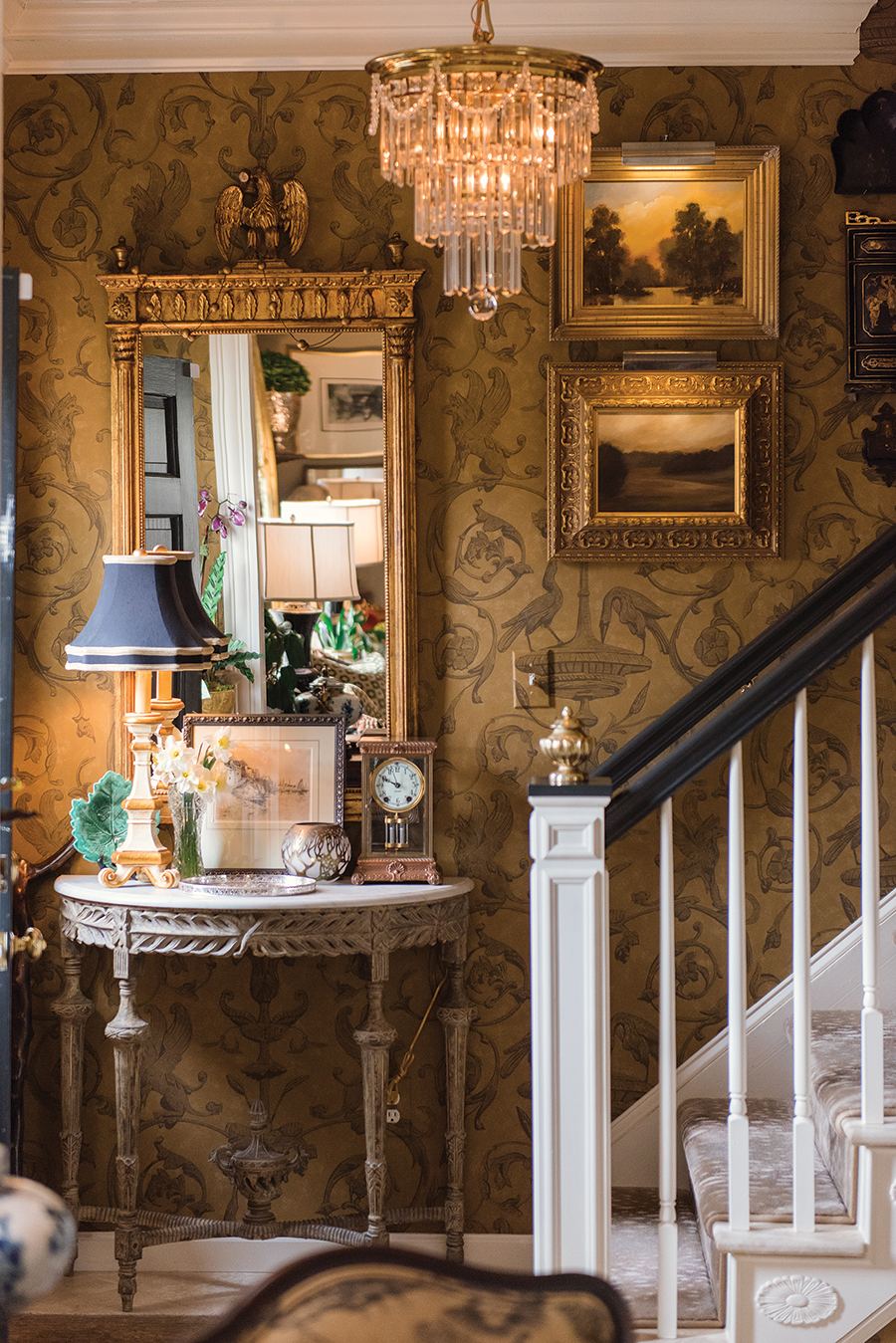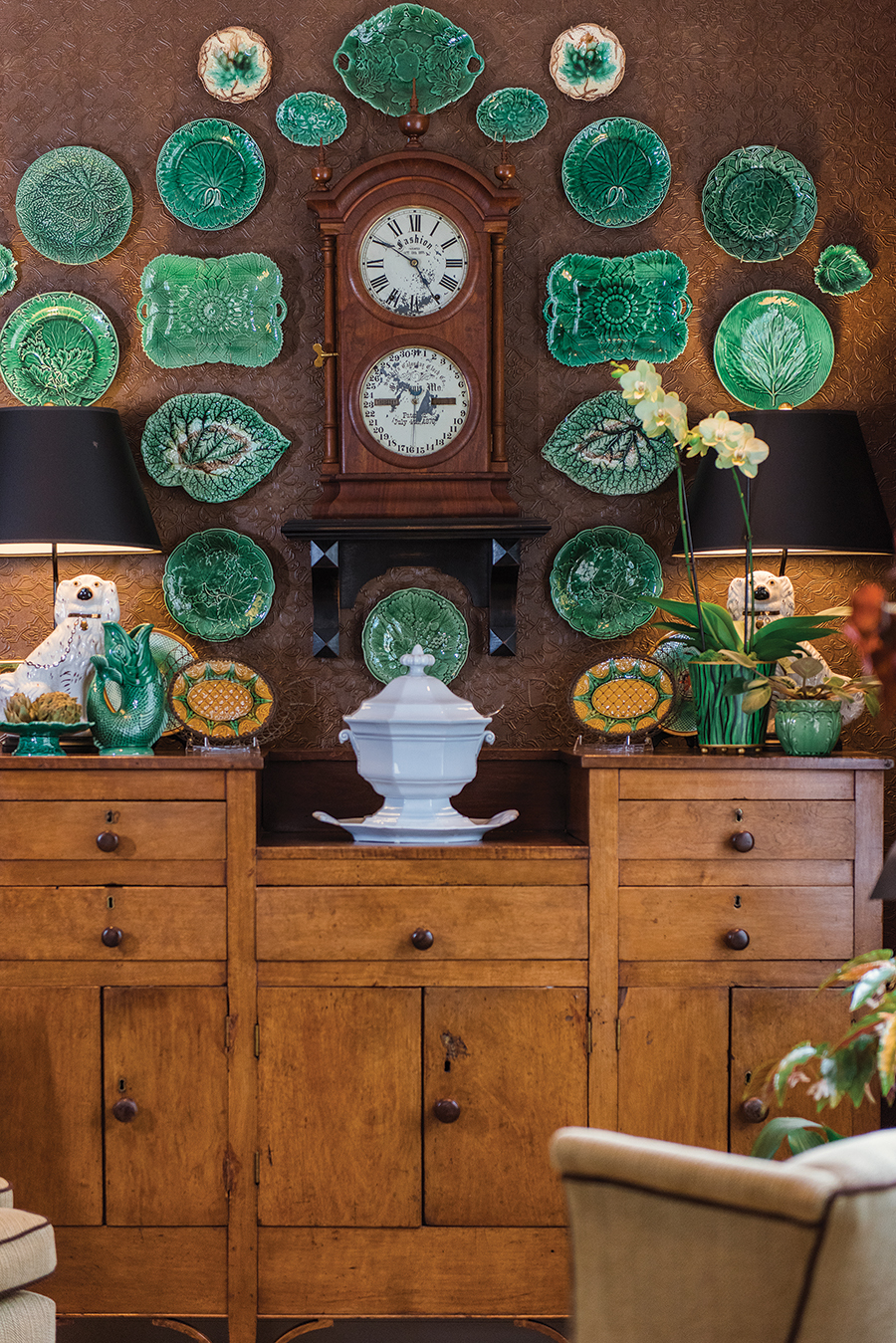
For designer and avid collector Terry Lowdermilk, nothing succeeds like excess
By Cynthia Adams • Photographs by Amy Freeman
It is so 21st-century to be a collector. When Country Living profiled collectors last year, their prized possessions sometimes numbered in the hundreds. And, the chosen objects ran the gamut: from highbrow to low, from cutting boards to stamps.
But amassing and curating specific items didn’t begin in this day and age. As far back as the Renaissance, Europeans created cabinets of curiosities, or “wonder rooms,” a pastime elevated to an art form by acquisitive Victorians.
According to neuroscientists, groupings of objects give us a pleasurable sensation, a little jolt of joy, even. This point was underscored by no less than famed designer of the Greenbrier Resort, Dorothy Draper, an affirmed “anti-minimalist.” In her 1960s Good Housekeeping column, she advised her followers to group objects in a pleasing arrangement. Groupings elevate lesser collections, she explained: “Notice how groups of small objects, when they are well-arranged, become important and effective.”
For serious collectors, (many of whom admit to having a plan of action to scoop up their collections first in the event of a house fire), the oft-repeated mantra, “less is more,” appalls. Consider Tony Duquette, the artist, film and stage designer who penned the hefty tome, More is More.

Interior designer and avid collector Terry Lowdermilk displays Duquette’s book in his living room . . . along with a whole lot more, by the way. As a neighbor and fellow collector says, Lowdermilk is a maximalist, placing him firmly in Duquette’s and Draper’s camp. His collectibles cover tabletops and chests, fill decorative cabinets, and are displayed on walls, brackets and surfaces throughout his two-story townhouse. The namesake of Terry Lowdermilk Interiors, he spends six days a week working with varied, farflung residential clients. He also keeps a home office, which he confesses, requires him to religiously dust his many collections. (He does so with pleasure, weekly.) And if his clients don’t have a collection, Lowdermilk says he’ll offer “to start something for them,” the designer laughs — and not ironically. Collections, he maintains, make a house exceptional. Collected objects whisper of history, of meaning, of a backstory worth sharing.
For Lowdermilk, chinoiserie accomplishes this feat. The French word (pronounced sheen-WAHZ-uh-ree) encompasses everything Chinese and East Asian, from furniture to wallpaper, china, porcelains, objets d’art, textiles and papier mâché. It became wildly popular, thanks to the Dutch East India Company, which included the collectibles in their haul back to eager Europeans. The popularity of chinoiserie never abates — and if it does, it resurfaces in a heartbeat or two. It expresses Europeans’ version of Chinese and East Asian décor, extending into gardens, architecture and even the performing arts. (Think: Gilbert and Sullivan’s comic operetta, The Mikado.) King Louis XIV admired the style, as did others to follow. The beau monde loved it as well; pagodas and pavilions interpreted the style in gardens of the well-heeled.
A chinoiserie cabinet takes pride of place in Lowdermilk’s dining room. The knockout statement piece was formerly in a relative’s Lynchburg house. “My cousin found one in another color he liked.” Lowdermilk couldn’t buy the cabinet fast enough, and uses it as storage for table linens, charger plates and cloth napkins. A remnant from a chinoiserie opium bed graces the foyer wall. A Japanned (lacquered) screen is in the living room. One of his most beloved collections is the assortment of French and English chinoiserie papier mâché items, many of them utilitarian objects like holders for matches and calling cards. The papier mâché imitations were inspired by more exclusive and costlier Chinese and Japanese lacquer ware. Decorated in gilt they depict various fanciful scenes in Asian landscapes.

“There are also several pieces that were gifts from close friends and clients. Along the way, in more recent years, I have become enthralled with antique cinnabar [fiery red pieces carved from mercury sulfite], as well as Japanned papier mâché and tole pieces,” Lowdermilk says. “I only have a couple of the tole, or commonly known as tin ware, which have gold Asian-styled paintings on a black background.” He admits that his papier mâché collection with gold-on-black paintings has perhaps run away with him: “I truly love the Asian feeling as well as the gold-on-black decoration. Also, the many beautiful shapes and sizes.”
As he shows his collections — with nary a dust mote in sight — Lowdermilk explains the origin of his love of luxe interiors with hand-selected collections: Chinqua-Penn, the Betsy and Jeff Penn manse in Reidsville.
“The muted colors. My love for painted murals,” the designer explains, can be traced back to this touchstone.
From his earliest memory, Lowdermilk’s family had an inside connection to the estate. Their entrée was a close family friend and personal secretary to Jeff Penn, whose family started Penn Tobacco Co. in Reidsville, which was ultimately purchased by American Tobacco Co. The secretary received frequent calls to be available when the famously globetrotting Penns shipped back antiquities and art from their travels, filling the 30-room mansion they built in 1925.
“So, when we were kids — Mrs. Penn had died by then in the early ’60’s — we would go over to Chinqua-Penn, because it had been given to the foundation at UNCG,” Lowdermilk recalls. “There were pictures of us outside, by the fountains. It was like nothing I had ever seen before. All the things! It was incredible!” he says, pausing thoughtfully. “I think that was my beginning [as a collector].”
With a particular fondness for the Penns’ extensive collection of Asian artifacts and artwork, he visited the estate on numerous occasions, eventually serving on the board of the foundation. “I learned so much about their collections, their origins and also value,” he says. “I even had the pleasure of helping to oversee the decorating of the home for Christmas for the last three or so years that it was open to the public.”

Notice a theme?
Many of the items Lowdermilk collects echo a time when the Bohemian elite obsessed over exotic Asian wares.
Even if you couldn’t actually visit Asia with the resources of a tobacco baron or the Vanderbilt railroad heirs in Asheville, you could still possess the sort of treasures they were fond of amassing.
But Lowdermilk explains it wasn’t solely Chinqua-Penn’s riches that revealed collected opulence to his eager eyes. They were opened at an early age, while glimpsing interiors and antiques tagging along with his father, a Realtor.
“I’d go with him to sign a listing agreement, and I’d ask why didn’t we have beautiful old furnishings,” Lowdermilk remembers.
His father’s retort? “I grew up with all that dusty old stuff. I don’t want it.” Neither did he keep many family pieces. Lowdermilk’s dad wanted what so many postwar families wanted: everything brand-spanking new, with modern conveniences.
Even this twist had a silver lining. His parents’ modernity led him to the world of interior design. When Lowdermilk’s parents became engaged, they first built and furnished a house on Cornwallis Drive and hired a decorator, to impart the latest 1940’s design.
“Growing up in a home, where my parents had design help, was one aspect that enticed me into the design field,” says Lowdermilk. “I liked seeing my Mom work with the decorator, looking at fabrics, wallpapers, accessories, etc.

“They wanted to go on their honeymoon and come back to a house all ready.”
The young couple consulted Morrison-Neese Furniture Company and chose Vi Cothran, a member of their large staff. (A firm so notable they helped establish the home furnishings industry in the Triad.) Later, Cothran worked with Cashion’s Furniture and Decorating. “She helped my parents with their three homes. I always grew up in a house done by her.”
No question, he knew from early days that the profession lent proximity to beautiful objects and homes. And collections.
“Antiques were something we did not have at home, since my parents chose to leave behind older pieces from their childhood and enjoy the new home décor of the late ’40’s through the ’60’s and ’70’s.” Sure, they retained a couple of family antique pieces, “but most of the furnishings were new of the day. I realized then, that my future had antiques in it, possibly furniture pieces, and more than likely small, interesting pieces,” Lowdermilk recalls.
It was fortuitous that Lowdermilk’s father was a friend to the late Otto Zenke, Greensboro’s premier designer of that era. Ironically, Morrison-Neese was the store who brought Otto Zenke to Greensboro in 1937, according to a 2005 article by Jim Schlosser in the News & Record.
“On Saturday mornings, I would sometimes accompany my Dad to his office, which was down the street from Otto Zenke’s studio and residence,” Lowdermilk remembers. “I would ask Dad if I could go down and walk through his shop.” With Zenke’s permission, the impressionable Lowdermilk would enjoy, he recalls, “seeing many beautiful things which were inspiring. Mind you, I was around 11 to 13 at this time.”
On an outing with his mother, a teenaged Lowdermilk noticed a reproduction, French-styled plaster-on-metal, large wall bracket. “I told her I was going to buy it, and she asked why, and where would I use it? I quickly said, ‘In my bedroom!’” he smiles at the memory. “I purchased it with my own money, and today, it is still something I love, in my living room. Now, I suppose I could say it is well on its way to being an antique! At least vintage!”
From one purchase a collection was launched. “Now I have collected quite a few older wall brackets, which hold many antique items I have collected.”

One collection spawns another, for collectors, are, if nothing else, a passionate lot, hunter and gatherer types who know where the best stuff is. Bringing it home is an irresistible impulse. In Lowdermilk’s case, that would also include Old Paris sugar boxes, European lithographs, books, clocks, and the visually stunning majolica and cinnabar.
He recalls the spark that ignited his admiration of majolica, a term for painted earthenware originating from Moorish Spain by way of Renaissance Italy. “My first antique purchase was a green majolica plate, found at Byerly’s Antiques, one of my all-time favorite places to find great things,” Lowdermilk says of the massive Triad store overlooking I-85 that closed 15 years ago. “From that time, I found many more majolica pieces there, as well as in shops all over.” He prizes a green majolica clock that was used on the film set for The Color Purple.
The cinnabar he collects is alluring both for its beauty and for its potential danger.
“Of course, the fact that red cinnabar comes from mercury sulfide — and is toxic — is one reason we do not see the genuine material used today. And, I am hoping my love for it won’t be a threat to my life! But there must be some vices in life that we enjoy that are not always healthy for us!”
The rarity and the detail of cinnabar also affects Lowdermilk. “The carving, which is so detailed, is fascinating to me in the cinnabar pieces I have, and have lusted over,” he muses.
Is there any limit to his visual curiosity and passion for collecting? Or to the idea of more always being more? Probably not. He admits to eyeing oil landscape paintings and checking out silver lusterware as avenues for his next collecting passion.
“I enjoy having these collections around me. They are my friends. Each time I have packed pieces up to move to a new home, I enjoy unpacking each and every one of them,” Lowedermilk reflects. “As with all of my antiques, I like knowing there is a story behind each and every piece. I just wish they could talk, and let me know where they have been, what they have seen, and the places where they have been allowed to reside.” OH
Cynthia Adams is a contributing editor to O.Henry. She once lugged a Scottish marble clock home in her hand luggage, and checked a suitcase filled with brass door knobs. She perfectly understands antique addictions.





